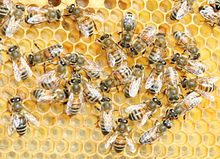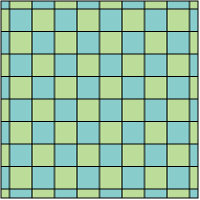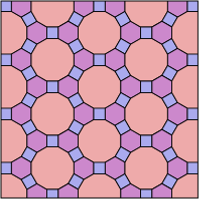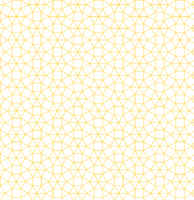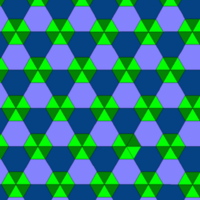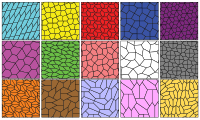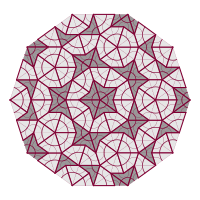Tiling
In the mathematics called tiling (including tiling , paving or surface-circuit ) gapless, overlap-free coverage of the (Euclidean) plane by uniform patches. The concept can also be extended to higher dimensions.
In practical applications, overlapping with the help of primitives (“primitive” surface shapes, if possible with a simple polygon ) is preferred, for which the correspondingly restrictive term tessellation (English for “ mosaic ”) is used. If a large sheet metal is to be divided into non-primitive partial areas (work pieces) in a technical application, an attempt is made to design these in such a way that there is parquet flooring through uneven partial areas and no waste is created.
The “cyclical division of areas” with non-uniform partial areas (no polygons) in art is very pronounced at MC Escher .
Analogous to the parquet or the tessellation of the plane (2D), the three- or higher-dimensional space can also be subdivided, see room filling .
Definitions
A tile (parquet stone, paving stone) is a closed topological disc in the plane. (This excludes, among other things, stones with holes and non-connected parts. Occasionally, however, such and more general stones are also permitted.)
A tiling (paving, tiling, sometimes also mosaic) is a (countable) set of tiles, which includes both a pack (ie, “no point of the plane is inside two or more tiles” or, in other words, “different tiles” have at most edge points in common ”) as well as an overlap (ie,“ every point of the plane belongs to at least one tile ”).
Often one restricts the term even further by z. B. demands that all tiles are homeomorphic to the closed circular disk (especially compact and simply connected ), or that each tile is congruent to an element of a finite selection of tiles (the so-called "proto-tiles"), that is only finite number of different tiles appear. If there is exactly one protocol tile, the tiling is called monohedral . It is required that the tiles are congruent with one another, but only similar to the protocol tile that characterizes the tiling . If there is a (monohedral) tiling of the level for a form (proto tile), one also says for short “the proto tile is tiled”.
Periodic tiling
A congruence mapping (Euclidean movement) of the plane, which maps each tile of a tiling onto a tile, is called the “symmetry” of the tiling. The set of all symmetries is called the symmetry group (the tiling). It is a subgroup of the group of Euclidean motions of the plane. If the symmetry group of a tiling contains two linearly independent shifts, the tiling is called "periodic" and the resulting symmetry group is a flat crystallographic group of which there are exactly 17, the so-called wallpaper pattern groups.
If certain requirements are placed on the basic shapes used in a tiling and their arrangement, special cases arise for which all possible tiling can be specified.
Platonic tiling
If only a regular polygon is permitted as a tile and there is a further restriction that the tiles must be arranged edge to edge, there are exactly three possible tiling of the level, which are called platonic or regular tiling :
Hexagonal grid - also called a honeycomb pattern
Johannes Kepler was the first to investigate this tiling and recognized that it is an analogue to the regular polyhedra.
Archimedean tiling
If any regular n-corner with the same edge length may be used as the basic shape, this results in retention of the edge-to-edge rule and the restriction that at every point where the corners meet, the same combination of polygons (number and order) must collide, exactly eight other possible tiling - the Archimedean , semi-regular or 1-uniform tiling of the level:
- 2 tiling made of triangles and squares
- 2 tiling made of triangles and hexagons
- 1 tiling from triangles, squares and hexagons
- 1 tiling of triangles and dodecagons
- 1 tiling of octagons and squares
- 1 tiling of squares, hexagons and dodecagons
Demiregular tiling
Tiling for which any regular n-corner with the same edge length is used as the basic shape and which adhere to the edge-to-edge rule, but in which one of two possible combinations of polygons is used at the points where the corners meet ( Number and sequence) is called demiregular or 2-uniform tiling , for example:
- Parquet from triangles and squares (different pattern than the corresponding Archimedean parquet)
- Parquet made of triangles and hexagons (different pattern than the corresponding Archimedean parquet)
- Parquet made of triangles, squares and hexagons (different pattern than the corresponding Archimedean parquet)
- Tiling from triangles, squares and dodecagons
- Tiling from triangles, squares, hexagons and dodecagons
There are a total of 20 demiregular tiling.
Dual tiling
Every platonic tiling is dual to another platonic tiling. Every Archimedean tiling is dual to a dual Archimedean tiling, which consists of congruent polygons . The side lengths of these polygons are the sum of the incircle radii of the original neighboring regular polygons . The corners of these polygons are the centers of the original polygons. The edges connect adjacent midpoints and therefore bisect the original edges and intersect them orthogonally . The original corners are the centers of the incircles of the polygons. The incircle radius is half the length of the original edges. The interior angles are equal to 360 ° / n, where n is the number of corners of the original polygon .
| Platonic or
Archimedean tiling |
Dual tiling |
|---|---|

|

|

|

|

|

|

|
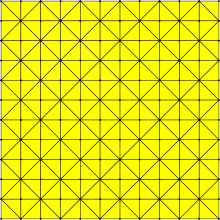
|
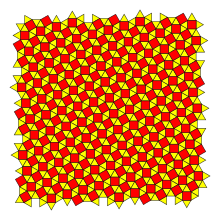
|

|

|

|

|

|

|

|

|
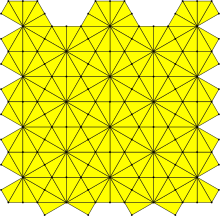
|

|
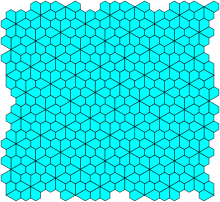
|

|
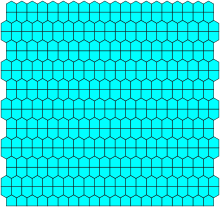
|
Tiling with irregular polygons
Parquet floors are also possible with irregular polygons. Examples are:
- Tiling with pentagons , like the Cairo tiling
- Parquet with hexagons and pentagons , like the Grazebrook parquet
The Dutch artist MC Escher is known for his tiling with exotic figures.
Isohedral tiling and anisohedral tiles
A monohedral tiling is called isohedral if there is a congruence map for every two tiles of the tiling, which maps one tile to the other. In Figure 2, the green can be converted into the blue rectangle by means of a point reflection at the center of the common side, the green into the yellow rectangle by rotating around the common corner and the green into the red rectangle by a combination of both. You can get close to the colorful rectangles by parallel shifting, as indicated by the gray arrows.
In this case, when the group of congruence maps operates transitively on the tiling, the tiling also consists of a single path . Is the number of lanes, the tiling is - isohedral called.
In the tiling in Figure 3, there is no congruence mapping that converts the dark green rectangle into the dark red one. The tiling consists of two strips, the greenish and the reddish rectangles, and is therefore 2-isohedral. Is that tiling is sometimes anisohedral called. When a tile is says it is -anisohedral or she has the isohedrale number (Engl. Isohedral number ,) if they parquetted and -isohedral not, but -isohedral for . Seen in this way, the (3: 1) rectangle in Figure 3 has the isohedral number 1, since it naturally also has isohedral tiling.
But there are also tiles that are tiled, but for which there can be no transitive tiling at all. One example is the paving stone by Heinrich Heesch (see Figure 4), in which the (mirrored) yellow and red tiles are required for the tiling, given the green and blue tiles, but there is no congruence, the green or blue tiles in yellow or red would convict. E.g. green or blue tiles can be converted into yellow or red by means of an axis mirroring, but the images of the yellow and / or red are offset by 2 rasters so that they cannot be made to coincide with green or blue tiles.
Aperiodic tiling
Sets of proto-tiles (see above) that only allow non-periodic coverages of the plane are called aperiodic or quasi-crystalline . Parquet floors can be quasi-periodic, which means that sections of any size can be repeated without the parquet as a whole being periodic. Interesting and beautiful examples of quasi-periodic tiling are the Penrose tiling , named after its discoverer Roger Penrose .
See also
literature
- Hans-Günther Bigalke, Heinrich Wippermann: Regular tiling , BI-Wissenschafts-Verlag 1994, ISBN 3-411-16711-4
- Bruno Ernst: The magic mirror of MC Escher , Taschen, 1992, ISBN 3-8228-0442-8
- Heinrich Heesch, Otto Kienzle : Flächenschluß , Springer, 1963
- Branko Grünbaum, GC Shephard: Tilings and Patterns. WH Freeman & Co., 1986, ISBN 0-7167-1193-1
Web links
- Mathematical handicrafts: Homogeneous tiling , by Jürgen Köller, 2004
- Spektrum.de: 100-year-old math puzzle - The end of the pentagonal saga , by Robert Gast, July 13, 2017 (about a possible proof by Michaël Rao (homepage) )
Individual evidence
- ↑ a b Heinrich Heesch, Otto Kienzle: Flächenschluß , Springer, 1963
- ↑ Bruno Ernst: The magic mirror of MC Escher, 7. The art of the Alhambra , Taschen 1978 and 1992, ISBN 3-8228-0442-8
- ↑ A protocol tile is therefore not necessarily a fundamental area in which there should not be any common points (not even edge points).
- ^ David Wells: The Penguin Dictionary of Curious and Interesting Geometry. Penguin Books, London 1991. ISBN 0-14-011813-6 . P. 213.
- ^ Ian Stewart: Pentagonal tiles. In: Spektrum der Wissenschaft , January 2000, pp. 106-108
- ^ Attack on the pentagon results in discovery of new mathematical tile
- ^ A b Joseph Myers Polyomino, polyhex and polyiamond tiling
